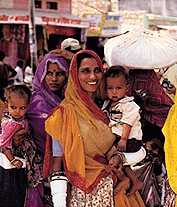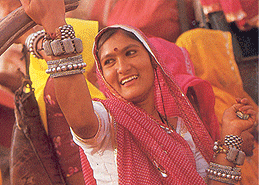|

|
About
Rajasthan
|

Welcome |
|
|
|
|
|
|
|
|
|
|
|
|
|
|
|
|
|
|
|
|
|
|
|
|
|
|
|
|
|
|
|
|
|
|
|
|
|
|
|
|
|
|
|
|
|
|
|
|
|
|
|
|
|
|
|
|
|
|
|
|
|
Information about
Rajasthan |
|
Rajasthan is one of the most fascinating regions in India, with one of the
oldest civilizations and extremely rich cultural heritage. Today, it is one of the
India's top performing regional economies. In 1999-2000, Rajasthan was the
fastest growing state in the country with a compound annual growth rate of
9.18 in addition to the states like Gujarat, Andhra Pradesh, Karnataka and Tamil Nadu.
Rajasthan came into existence as a constitution of 19 princely states and 3
chiefships which varied in size, administrative efficiency and socio-economic
development. At present, Rajasthan is divided into 32 districts which are
further divided into 241 tehsils, 183 municipalities, 237 Panchayat Samities
and 9184 village panchayats. Karauli district is the latest addition in the category of districts in the State. |
 |
|
The Rajasthan government's main aim is to develop it as a first league developed
state where its people get ample opportunities to achieve economic prosperity
and enjoy a high quality of life. It has taken firm and effective steps to
ensure the consistent all round development. Besides always taking an
investor-friendly approach, the state has aimed at creating a very positive
environment for progress of industry. Such efforts have secured an important
place for Rajasthan, among the forward-looking states in the country. |
|
|
|
Location of
Rajasthan |
|
Rajasthan is one of the 26 states that, along with seven union territories, forms the republic of India. Rajasthan is situated in the north western part of India.
Rajasthan covers a total area of 3,42,274 square km. that comprises of 22 princely states, making it geographically the second largest state in India.
Rajasthan is bounded by Pakistan in the west and north-west, by Punjab and Haryana in the north, by
Uttar Pradesh in the east, by Madhya Pradesh in the south-east and Gujarat in the south-west and south.
Its north-western and western regions which comprises of 11 districts forms the "Great Indian Thar
Desert". Rajasthan is located between 22o and 30o north latitude, and 69o and 78o east longitude and
consists of the Aravalli hills, the plateau of Haroti and the Malwa tableland that block the flow of the
monsoons to the region, creating the vast desert that lies to the west.
The Aravali mountain ranges that run from Delhi to Gujarat runs across the State in the south-east and
north-west direction. The north-west region covering two-thirds of the state consist mostly of a series of
sand dunes. Bikaner, Jaisalmer, Jodhpur and part of the Jhunjhunu districts form part of this region. |
|
|
|
History of Rajasthan |
|
Rajput clans emerged and held their sway over different parts of Rajasthan from about 700 AD. Before that, Rajasthan was a part of several republics. It was a part of the Mauryan Empire. Other major republics that dominated this region include the
Malavas, Arjunas, Yaudhyas, Kushans, Saka Satraps, Guptas and Hunas.
The Rajputs control the whole of Rajasthan during the period from the eighth to the twelfth century AD. The Pratihars ruled Rajasthan and most of northern India during 750-1000 AD. Between 1000-1200 AD, Rajasthan witnessed the struggle for supremacy between Chalukyas, Parmars and
Chauhans.
Around 1200 AD, a part of Rajasthan came under Muslim rulers. The principal centers of their powers were Nagaur,
Ajmer and Ranthambore. At the beginning of the 13th century AD, the most prominent and powerful state of Rajasthan was Mewar. Rajasthan had never been united politically until its domination by Mughal Emperor - Akbar. Akbar created a unified province of Rajasthan. Mughal power started to decline after 1707. The political disintegration of Rajasthan was caused by the
dismemberment of the Mughal Empire. The Marathas penetrated Rajasthan upon the decline of the Mughal Empire. In 1755 they occupied Ajmer. The beginning of the 19th
century was marked by the onslaught of the Pindaris.
The erstwhile Rajputana comprised of 19 princely states and two chiefships of Lava and Kushalgarh and a British administered territory of
Ajmer-Marwar. The present State of Rajasthan was formed after a long process of integration which began on March 17,1948 and ended on November 1,1956. Before integration it was called Rajputana
and after integration it came to be known as Rajasthan. At present there are 32 districts (including the new district of Karauli), 105 sub-divisions, 241 tehsils,
37889 inhabited villages and 222 towns in the state. |
|
|
|
People of
Rajasthan |
|
 |
The people of Rajasthan are famously called the Marwaris. The term Marwari
means a cunning businessman from the Rajasthan. The Birlas, Goenkas, Ruias
and Singhanias are among the top business groups of India. They are the famous marwaris from Rajasthan. The people of Rajasthan are of course, a lot more than the popular
marwari. The term marwari is used rather sweepingly over a diverse set of people.
Equally famous are the Rajput chieftains of Rajasthan. These are the ones who built the grand forts, palaces and havelis of Rajasthan. History is replete with legends of their bravery,
|
|
their romantic forays and their adventures. Local ballads sing songs of their valour and their sacrifices.
Rajasthan comes alive with its folk dances, melodious music and spectacular
festivals. Typically, men still wear twirling moustaches and women adorn themselves in multihued costumes. The people speak local dialects, and an old saying explains that the dialect and the men's turban change every 24 miles. The group of dialects spoken in Rajasthan is called
Rajasthani. |
|
|
|
|
Climate of Rajasthan |
|
The climate of Rajasthan
varies from semi arid to arid. During summers, the temperature remains
about 45o Celsius and days are very hot and dry. While, in
winters the temperature remains about 10o Celsius on an average
and even drops below freezing point. The days are filled with sunshine and
thus, this is the best time for visitors to travel within the state. |
|
|
|
How to Reach Rajasthan |
|
The major
cities of Rajasthan are well connected among themselves. The capital city
of Rajasthan, Jaipur has its own airport and is linked to various other
cities and tourist destinations. The major cities of Rajasthan are also
well connected with various cities and its neighboring states by the
railways, roadways and airways network. |
|
|
|
|
|
|
|
|